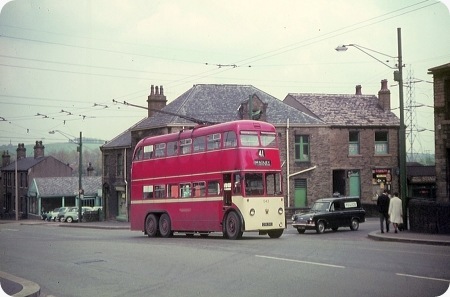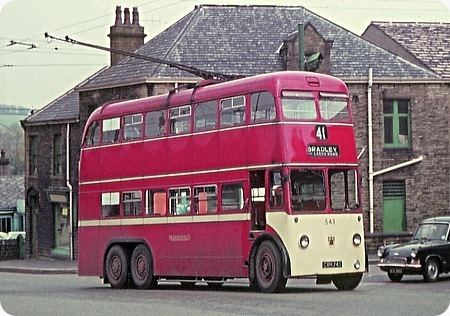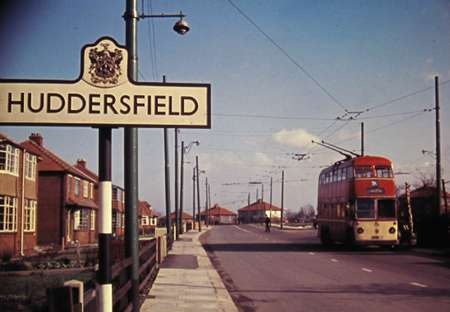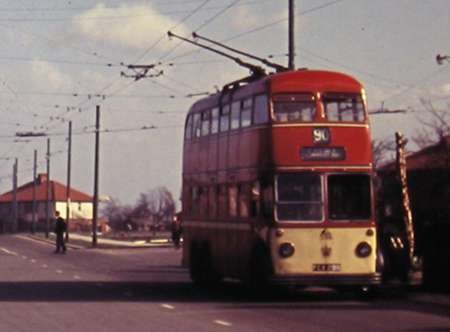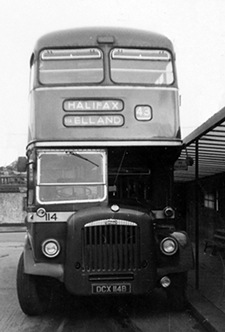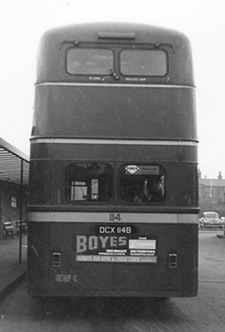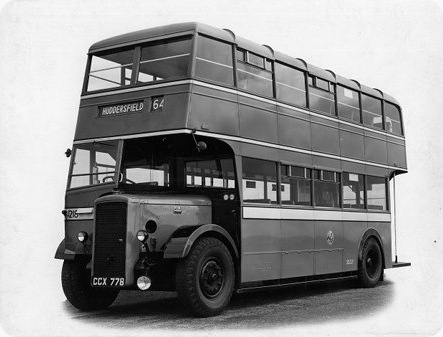
Photograph by ‘unknown’ if you took this photo please go to the copyright page.
Huddersfield Corporation
1945
Daimler CWA6
Duple L55R
This is obviously a pre delivery photograph of a Huddersfield Joint Omnibus Committee vehicle, note the combined Huddersfield/LMS Railway crest on the nearside panels. The bus is in full fleet livery so must date from the end of the war. The service 64 shown on the blinds was Huddersfield to Bradford operated jointly with Bradford Corporation and Hebble. The livery is smart but restrained and continued in the same layout until the Joint Omnibus Committee was wound up in 1970. It’s an unusual place for the licence holders!
Photograph and Copy contributed by Ian Wild
A full list of Daimler codes can be seen here.
31/07/11 – 10:40
This is a splendid picture of a most interesting vehicle. I always think that the Duple utility bodies, especially the later versions like this one, were extremely tidy and pleasing in appearance. From personal experience of working on many such vehicles I can also vouch for the fact that they were of excellent construction, and must overall have cost far less in major rebuilding than most other utilities. The sliding ventilators are of a design that I don’t think I’ve noticed before and appear quite robust. As Ian rightly says, the position of the licence discs is unusual and, I would have thought, vulnerable to weather and to lubricant vapour – although I ought to retract the latter of those two references as I believe that Huddersfield maintenance was of the finest !!
Chris Youhill
31/07/11 – 12:21
I’m glad to say that sister ship CCX 777 is with Stephen Morris at Quantock Motor Services and runs extremely well. I do agree with Chris Y: handsome bodywork, simple and perfectly proportioned. But I think the licence discs have been moved to a less exposed position!
Ian Thompson
02/08/11 – 07:14
It’s a little unusual for a lowbridge vehicle to have the upper deck handrail continued all the way along the nearside of the bodywork, this revives memories of the twin gangway subject, which this is very obviously and most certainly not!
Chris Barker
02/08/11 – 20:31
Huddersfield Corporation always set a high standard specification for its buses so protective handrails on the upper saloon are not surprising. I have a picture of Daimler CWA6 CCX 777 taken in 1990 which also has an upper saloon safety handrail and a tax disc in the cab which was a standard location for Huddersfield. Quite a number of pre-war built low bridge bodies were also fitted with safety rails on the upper saloon nearside and supplied to various operators. London Transport Duple Daimler CWA6s D1 to D6 were similarly fitted with safety rails all round the upper saloon. Maybe these rails were more common than first perceived.
Richard Fieldhouse
03/08/11 – 06:43
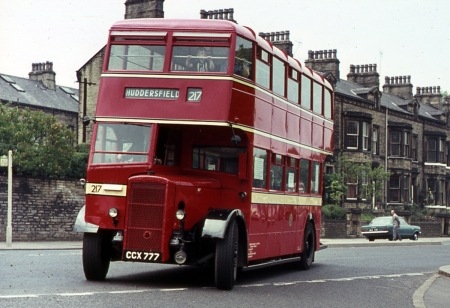
The appearance on the website of a picture of a wartime Daimler CWA6/Duple L27/28 of Huddersfield Corporation has prompted me to send the above photo of the restored example of this batch, CCX 777. The pictures was taken on 15th June 1968 at the Halifax Passenger Transport parade of old vehicles that formed part of the celebrations held to mark the 70th anniversary of the running of the first tramcar in the town. I have several other pictures from this event that I can supply in due course if any one is interested.
Roger Cox
04/08/11 – 07:12
Richard is right about LPTB’s D1-6 having safely rails ALL around the upper deck, even extending across the rear emergency exit!
Chris Hebbron
04/08/11 – 07:16
Thank you for this, Roger. It brings it all back. The tot at the upper deck window had no connection with the bus. At the start of the parade, he and his mum were looking up and down the line of buses, and she suddenly announced "This is ours!" and got on. We allowed them to stay, but we did touch them for a donation!
Peter Williamson
04/08/11 – 21:42
The Halifax climate produced a real rarity for that occasion, Peter – a wonderfully fine day. It is a sobering thought that the "tot" is now well into his forties!
Roger Cox
05/08/11 – 07:46
This recent correspondence puts me in mind of one of my favourite batches of Bradford buses, Nos 487-501 of January 1945.
These too were lowbridge utility CWA6 Daimlers with Duple bodies, and I well remember being unable to retain my dignified posture when the bus cornered, as there was no cohesion between clothing and wood lathe seats. Quite exciting and different they were, when compared with more dignified BCPT vehicles.
Examination of photographs, and trawling of memory tells me that these, too, had a white safety rail along the nearside of the upper deck, so perhaps this was a standard Duple feature. 487-501 had the shell back dome, as on London`s D1-D6, and I am still wondering why the MOWT allocated them to Bradford, who did not need lowbridge buses, and when some fleets such as Huddersfield DID need them. I wonder also why there was not more interchanging among municipalities to iron out these requirements, as this happened quite frequently amongst company operators. Huddersfield obtained a highbridge CWA6, presumably unwanted as such, at about the same time.
Whilst on the subject of municipal utility buses, I wonder why some fleets maximised their use with commendable efficiency, whereas others disposed of them with unseemly haste, never for them to run again for anyone else. Whatever happened to the Brush CWA6s of Manchester, for example, and why did some, including some of the Bradford Harriets, disappear after withdrawal in 1952, whilst at a later date, London’s "D"fleet was quite sought after Municipal politics I suppose.
John Whitaker
05/08/11 – 14:58
The absurd thing about London Transport’s disposal of utility buses was that, being (albeit only a technicality, operationally) part of BTC, it was not allowed to sell them to any competitor, yet some of them had been overhauled and other operators would have gladly had them. Instead, they, along with other types, such as the post-war STD’s and even ‘Scooters’ went to such as the Atomic Energy Commission and Belfast Corporation and overseas to places such as the Canary Islands, Jugoslavia, Ceylon. Such a short-sighted policy.
Chris Hebbron
06/08/11 – 07:00
That is very interesting Chris. I obviously knew that LTE could sell to other UK operators, but that it was competitors to whom sales were restricted. By competitors, I presume they meant operators abutting onto their area of operation. Most London sales were via dealers, I think, especially Norths of Leeds, but some were direct? Sales to Belfast and Southend come to mind. There were not many London sales to other UK operators before 1950, with a few exceptions even going as far back as B types, some of which went to Birkenhead corporation.
I must agree with Chris Y about Duple quality at this time. They were obviously doing their best to improve build quality under very trying circumstances, as the introduction of minor changes demonstrates. For example, Bradford’s 476-479 of November 1943 (early CWA6s), did not have the shallower stepped cab window of later batches. This would have allowed more solidity into the framework at the critical front bulkhead area. All very interesting stuff!
John Whitaker
06/08/11 – 07:01
This will not be a pre-delivery photo as suggested. The windows are full of traffic notices. I know a lot of things could be applied at the builders, but never something as ephemeral as that.
Huddersfield seem to have been in the habit of photographing their buses although I’ve no idea what they did with the photos!
David Beilby
06/08/11 – 07:02
John, in a published photo of 496 in its new guise as Nottingham City Transport 47 the nearside safety rail upstairs is prominent. It is also clear that downstairs at least, the seats were upholstered by then, but the caption does say that they were extensively refurbished before entering NCT service.
Stephen Ford
06/08/11 – 07:03
One factor to bear in mind is the difference between utility (wooden seats, no opening windows) and relaxed-utility. The Huddersfield CCX Daimlers were the latter. CCX 777 stayed at Huddersfield for around 10 years, then worked at West Bridgford for slightly longer, and is actually quite comfortable and civilised. Full utility buses would have needed reseating and other modifications for prolonged peacetime use, and in some cases the structural integrity of the bodywork may not have merited this.
Manchester considered rebodying their CWA6s but rejected the idea after examining one that had been done by another operator. I don’t know why.
Peter Williamson
06/08/11 – 15:08
The whole topic of utility versus relaxed utility can be quite confusing.
I believe that individual restrictions such as the number of opening windows allowable, and the use of panel beating were "relaxed" as circumstances changed for the better. This was on an "ad hoc" basis rather than an "overnight pronouncement", and the term "relaxed utility" is one compiled later by transport historians. The use of wooden seats is another example, as there are plenty of examples of utility buses supplied with upholstered seats before the advent of the so called "relaxed utility" era. Indeed, in the early utility period, whilst stocks lasted, upholstered seats were fitted to many vehicles.
Bradford`s 1943 Massey bodied CWG5s for example, were so fitted, whereas later ones were not, but in Bradford`s case, wooden seats were generally replaced by upholstered ones from pre – war withdrawn stock.
As there were no pre war lowbridge seats apart from TD1 Titans, there was a further circumstance for the withdrawal of the Flat Harriets, so those sold to Nottingham must have been re-fitted before use by NCT
Thanks to Peter and Stephen for their interesting comments.
Interesting Stephen that second hand Duple bodied utility Daimlers ran on the same (Wilford) area routes for both NCT and WBUDC. Did West Bridgford not also rebuild some pre-war Park Royal Regents into lowbridge from highbridge for the same end use? \Bradford "Flat Harriets" or "Pig Troughs " for NCT, and the more refined ex-Huddersfield product for West Bridgford. West Bridgford just has to be one of my favourite fleets!
John Whitaker
06/08/11 – 18:36
In addition to the utility/relaxed utility debate there was also the issue of “unfrozen” – which I understand to be work in progress at the time of the ban on bus production, which the Ministry of War Transport eventually allowed to be completed and released, in advance of the utility specification being issued. I understand, for example, that Grimsby Corporation suffered devastating damage to several of its fleet as a result of a butterfly bomb landing on or near the Victoria Street depot. At least two of their Roe-bodied centre entrance Regents were resurrected with rather tasteful conventional rear-entrance East Lancashire bodies that were unfrozen.
John, you are right. West Bridgford had two of their 1936 Regents (8 & 9, CRR91-92) rebuilt with Willowbrook lowbridge bodies in 1952, as their first vehicles for the Clifton service. (After a long-running row, NCT was allowed to run 50% of the Clifton service, with 25% each going to WBUDC and South Notts). 1939 Regent no.4 (FNN 102) was similarly treated in 1953. They lasted until 1957 (8 & 9), and 1965 (4). WBUDC then purchased new manual AEC Regent IIIs no’s 11 and 21 (ORR 139-140) in 1954, and finally in 1955 acquired the two 1945 Huddersfield utilities CCX 777/779, which became 24 and 27. They survived until 1967 and 1965 respectively. After the arrival of the three Reading bodied Regent Vs in 1958 I don’t think the older vehicles accumulated much mileage, but even so the 22 year service life of no.24 wasn’t a bad innings for a utility.
Stephen Ford
07/08/11 – 15:39
You are correct about "unfrozen" category Stephen, although , again, this a title which was framed later. All outstanding chassis and body products were allowed to be completed, making for some interesting combinations, as original intent was not always realised.
The East Lancs rebodied Regents at Grimsby were very similar to some Regents rebodied for Bradford, where the original all-metal EEC bodies had become unserviceable. As mentioned before, East Lancs were designated as a rebodying concern only, and not "licensed" to build on new chassis in the war period, from the start of the utility era.
John Whitaker
Today 14th August was the Annual Bristol Bus Running Day and I was most surprised to see CCX 777 arrive! Having seen the above picture of the bus when first saved for preservation in 1968, I thought readers might be interested in seeing how it looks forty three years later! As you can see it is in fine running order and I took two pictures of the inside showing a few details of the utility construction. There was nobody around to ask permission to climb aboard to capture the upper deck but at least these show that the bus is in safe hands!
//farm7.static.flickr.com/6200/6042997011_e2b8b3826e_b.jpg
//farm7.static.flickr.com/6190/6043546162_1c994d85a7_b.jpg
//farm7.static.flickr.com/6198/6043000273_ee801baaa3_b.jpg
//farm7.static.flickr.com/6137/6043001391_b33ee82f13_b.jpg
//farm7.static.flickr.com/6195/6042998235_c0d27b1a07_b.jpg
Richard Leaman
15/08/11 – 13:14
‘Unfrozen’ also included assembling chassis and bodies from spare parts with minimal additional work. London Transport were allowed to build 20 lowbridge STL bodies to cater for high-capacity single-deck routes. They looked pre-war superficially, but were single-skinned inside, possessed reduced front and no rear/side blind displays and spartan seating. They were put on existing chassis, and Chiswick’s other ‘real’ STL unfrozen bodies were put onto AEC’s unfrozen chassis. These bodies were all different, some with with a front display designed for a roof box, but no roof box fitted! They, too, were stripped out versions, the chassis having crash gearboxes, sensibly being sent to country services. In some respects, London Transport was lucky during the war, despite compensating trials and tribulations, its 4%(?) float of spare bodies for overhaul purposes came in handy when buses were ‘blitzed’, for the chassis usually survived and could be re-bodied with a float example, although, in the end, even these ran out!
Thank you, Richard, for bringing back childhood memories of the lowbridge ‘D’s’ which frequented my part of the post-war world in Morden on the almost circular route 127 between Morden and South Wimbledon. The blind display is not right, but it was not an LT bus, so I’m not carping. It was good of the owners to paint it in this livery! I dread to think of the preservation work put into these austerity bodies over the years to keep them on the road! Like HMS Victory, I suspect only 30% of the original bodywork is still extant! Very like the veritable broom which has had three handles and four heads, but is still the same broom!
Chris Hebbron
17/08/11 – 07:30
I agree that it was good of the owners to attempt to create as near as possible a representation of an LT D class although I am a bit of a sceptic about ‘fake’ liveries. I wonder if they would consider painting it in WBUDC livery, with whom it spent the greater part of its working life!
Chris Barker
17/08/11 – 10:33
That would indeed by very nice Chris – but I guess it would still remain highly inauthentic unless the screens were rebuilt to accommodate the gigantic WBUDC "61 Clifton Estate via Trent Bridge" display that could be read almost before the bus itself appeared!
Stephen Ford
18/08/11 – 08:05
Are you sure CCX 777 (WBUDC 24) ever had the gigantic destination display? I don’t recall this having to be modified when it entered preservation as Huddersfield 217. I thought all that was needed was a repaint. I too would like to see it in WBUDC livery, but the owner is a commercial concern, and favours red buses to the extent of painting a Leeds Daimler CVG6LX-30 in Huddersfield livery!
Peter Williamson
18/08/11 – 10:09
Steve Morris is a serious preservationist who knows exactly what he is doing. The Leeds CVG is in Huddersfield livery because it ran in it after disposal by Leeds – not its original livery, but authentic. There must, therefore, be a good reason for what has happened to CCX. [It was certainly specially decked out as a Sutton D for the Carshalton running day a few years ago which celebrated the 127, particularly it’s demise with the concurrent removal of the RLHs.] It’s nothing to do with him preferring red – he has and has had plenty of green and cream vehicles in his preserved fleet.
David Oldfield
19/08/11 – 06:55
It should have been decked out as a Merton ‘D’, which was where the lowbridge version was garaged for the 127/152/Epsom Races services they were authorised to run on. Only the 100 relaxed spec ‘D’s were at Sutton. But who cares; any excuse is reasonable to see these old-timers run!
Chris Hebbron
20/08/11 – 14:02
Here is a photo of what appears to be PMT utility Daimler B58. This caused quite a stir at the POPS bus rally in 2007, until someone suggested we look at the licence disc, which of course said CCX 777.
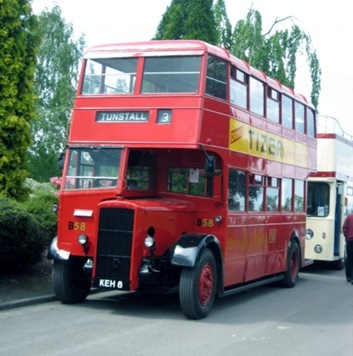
I believe Steve Morris is a native of those parts.
Peter Williamson
23/08/11 – 10:11
With regard to the WBUDC question, I’ve just found a photograph which I’d forgotten I had, which shows that CCX 777 was not fitted with the giant size destination display, it was however fitted with a small route number display on the nearside above the platform, which was standard on all their rear entrance double deckers. It’s strange that if they went to the trouble of fitting this, they didn’t modify the front at the same time. If it never carried the large display with West Bridgford, I would imagine that it was the only vehicle in the fleet that didn’t.
Chris Barker
23/08/11 – 10:12
The Leeds Daimler once owned by Steven Morris (now exported to Venice) never ever carried Huddersfield livery when transferred to Metro Kirklees. They ran in Leeds livery with 42xx numbers until they were overhauled at Great Northern Street, Huddersfield when the orange rooflights were removed and they were repainted in Verona Green and Cream. They were also renumbered 871-875 at this time
David Hudson
23/08/11 – 14:22
The Leeds Daimlers which went to Huddersfield were always the odd ones out in Leeds. Indeed LCT tried to sell them when only a few years old as non-standard. Of course they fitted in very well in Huddersfield. They were the only front engined Leeds buses to wear PTE livery
Chris Hough
24/08/11 – 08:00
Not only was Steven Morris’s ex Leeds Daimler never operated in Huddersfield livery but the style Steven painted it in was not authentic Huddersfield either. Apart from the shade of cream looking too light (I only have photos to go on) all three cream bands where different.
The lower cream band should be below the ‘Roe Rail’ and the top band was narrower than the middle one which in turn was much narrower than the bottom one. The sweep of the cream curve from the front panel to the upper band also doesn’t look right, although this is open to debate.
Eric
21/09/11 – 06:17
At the bottom of the page on "Huddersfield Corporation – Daimler CWA6 – CCX 778 – 218" there is a question which refers not to this Daimler CWA6, but to Stephen Morris’s ex-Leeds CVG6 which was painted in Huddersfield’ colours: "Anyone got a shot of this Leeds Daimler in Huddersfield livery."
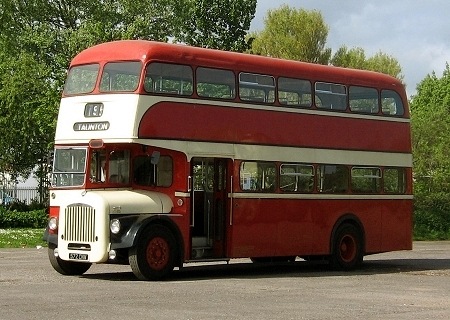
Please find attached a choice of three shots which I took in the coach park at Minehead during the Minehead Running Days on 2nd/3rd May 2009. I did ask Stephen why it was painted in Huddersfield colours, and the reply was simply "because he liked the livery"!
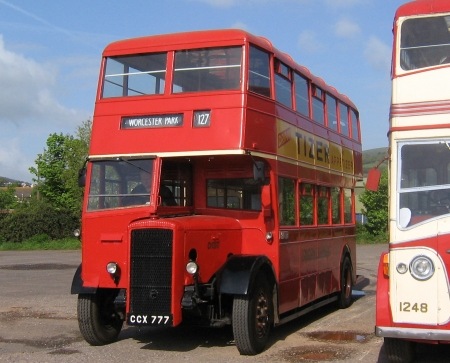
I have also attached a photo of CCX 777 taken at the same event. It is (or was, at the time) painted in London Transport livery, as it had been used in the making of a film. I drove this vehicle from Minehead back to it’s depot just outside Taunton at the end of the day, and it drove beautifully.
Dave Jessop
21/09/11 – 15:42
Leeds/Huddersfield CVG6- Is it the camera, or should we be a bit more cream….?
Joe
21/09/11 – 18:16
The Huddersfield liveried Leeds Daimler is now on the continent as a snack/coffee bar in Vienna!
Chris Hough
22/09/11 – 06:19
Oh Chris H – I WISH I’d known that a few weeks ago as I had three nights in Vienna in August, and would love to have taken some pictures of the Bradford/Morley/Ledston Luck flyer.
Chris Youhill
07/02/13 – 14:09
The other Saturday I was desperately looking for something to watch on the tele that wasn’t trying to insult my intelligence, and I came across an old episode of Last of the summer wine ‘I know’ anyway, CCX 777 was in it. I didn’t catch when the episode was made, but Bill Owen ‘Compo’ was in the cast so that takes it back a few years.
Ronnie Hoye
08/02/13 – 06:33
The bus was used in the 1981 Christmas special.
Chris Hough
10/02/13 – 16:40
Continuing the bus-related ‘Last of the Summer Wine’ theme, preserved West Yorkshire Bedford OB/Duple coach CP1(FWW 596) appeared in the last episode of all. A lovely supporting role. The only blot on the landscape was that the stately old thing had to suffer the indignity of being made to belch out clouds of exhaust smoke for comic effect. As if….! Such antics should be left to Mark 1 Leyland Nationals surely?
Brendan Smith
17/01/14 – 09:43
I always enjoy rummaging around this website and most recently have come across the entries relating to the preserved ex-Huddersfield/WBUDC vehicle listed among the “Duple bodywork” heading. Here is a so-so shot of mine taken I think, summer 1966 of sister CCX779 cast aside after withdrawal, seen at the Abbey Road depot yard.
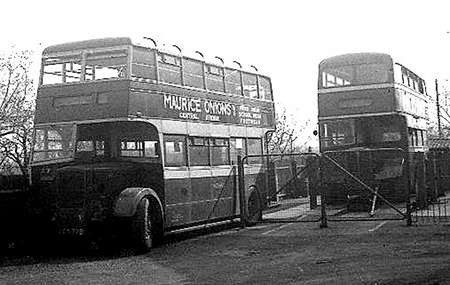
Note that the destination display had NOT been altered to the more expansive usual WBUDC style, and I recall that “CLIFTONESTATE” appeared to be presented as ONE word crammed into the available aperture. Alongside is ex-NCT Roberts bodied Regent III 328, acquired as a source of spares, no doubt for WBUDC`s still numerous iconic fleet of Park Royal bodied Regent IIIs.
Rob Hancock
 Vehicle reminder shot for this posting
Vehicle reminder shot for this posting
07/02/22 – 06:43
In reply to David Beilby’s comment from August 2011, about Huddersfield taking photos of their vehicles, I spent some time in the engineering department whilst on placement from college in 1972. I managed to borrow a number of photos to have copied, some of which had the background blanked out, but I don’t recall seeing this one of CCX 778.
Ian Charlton
